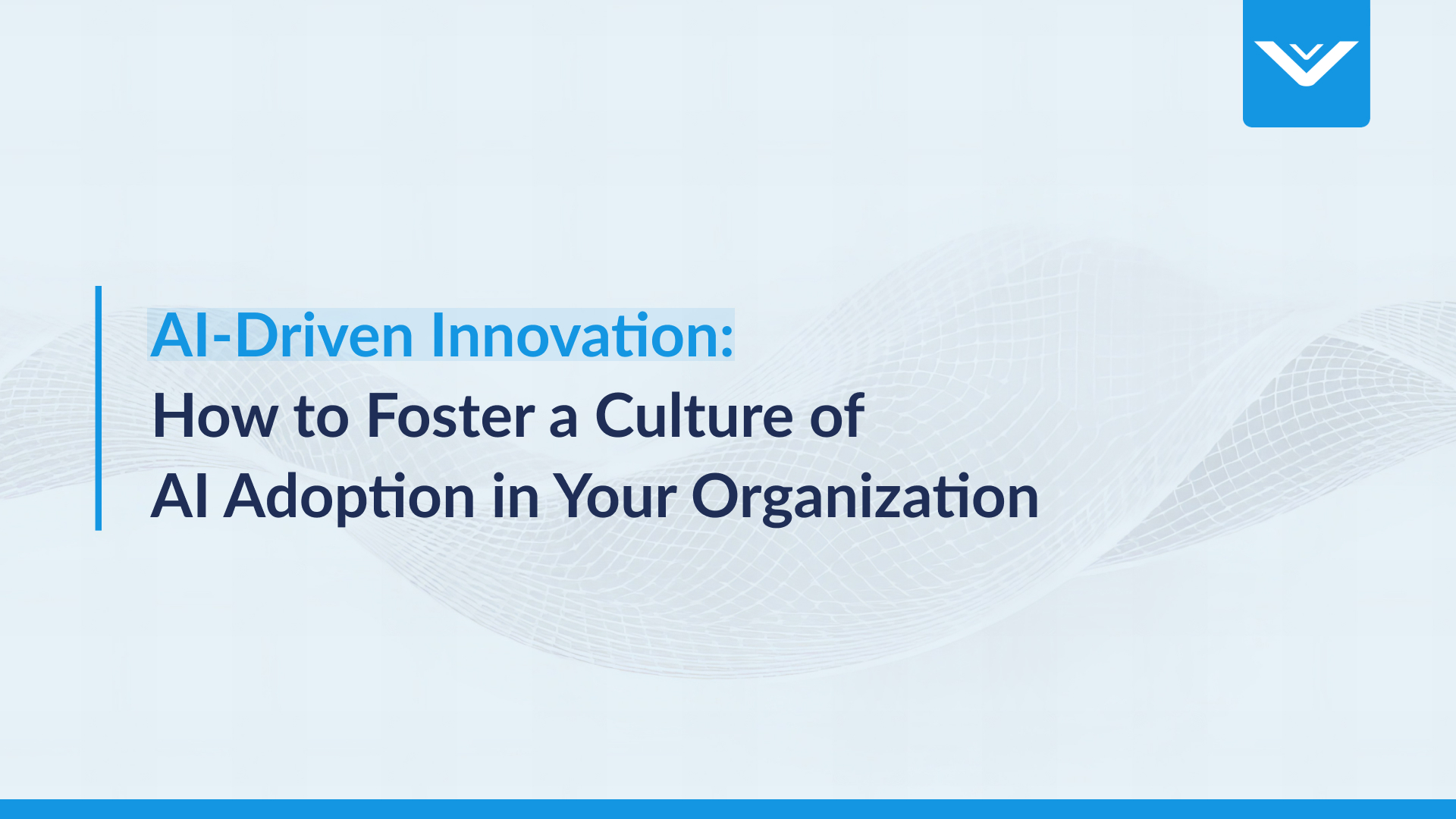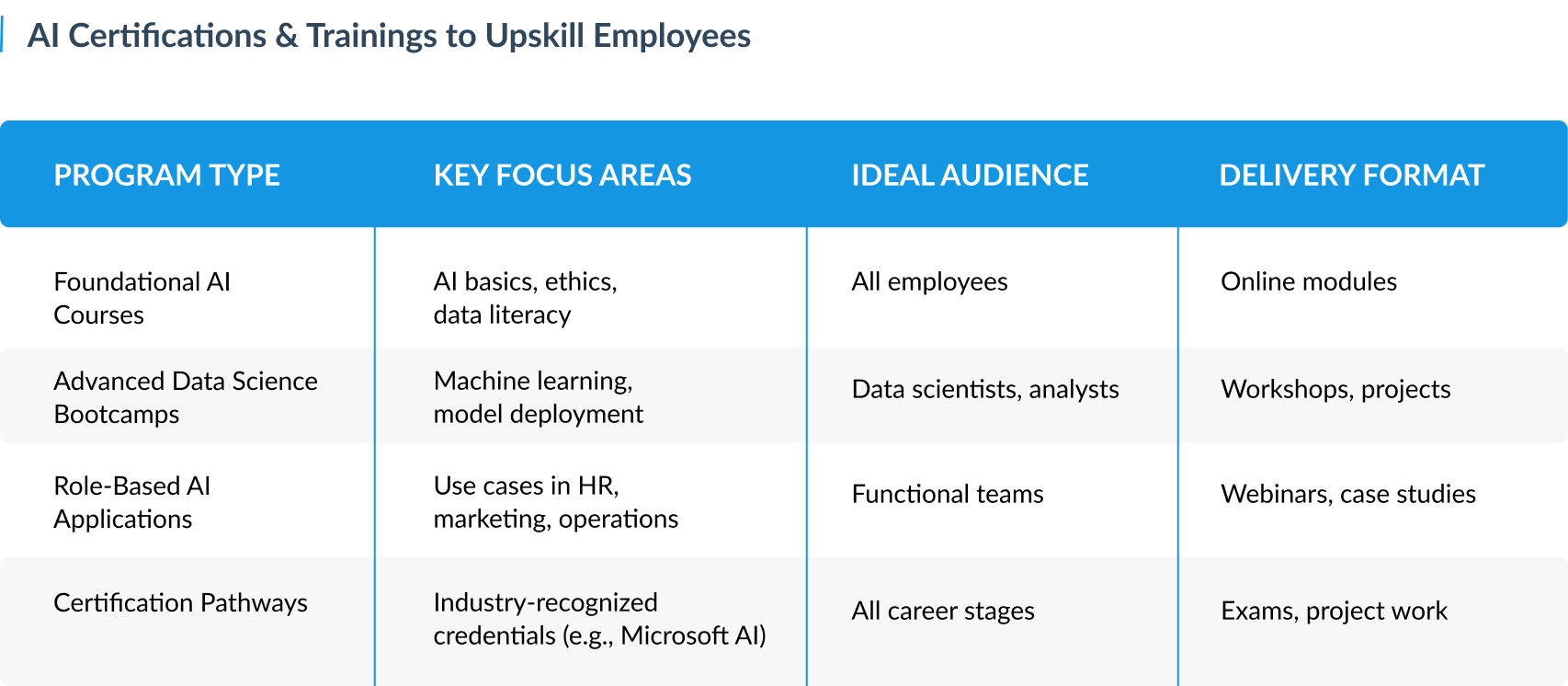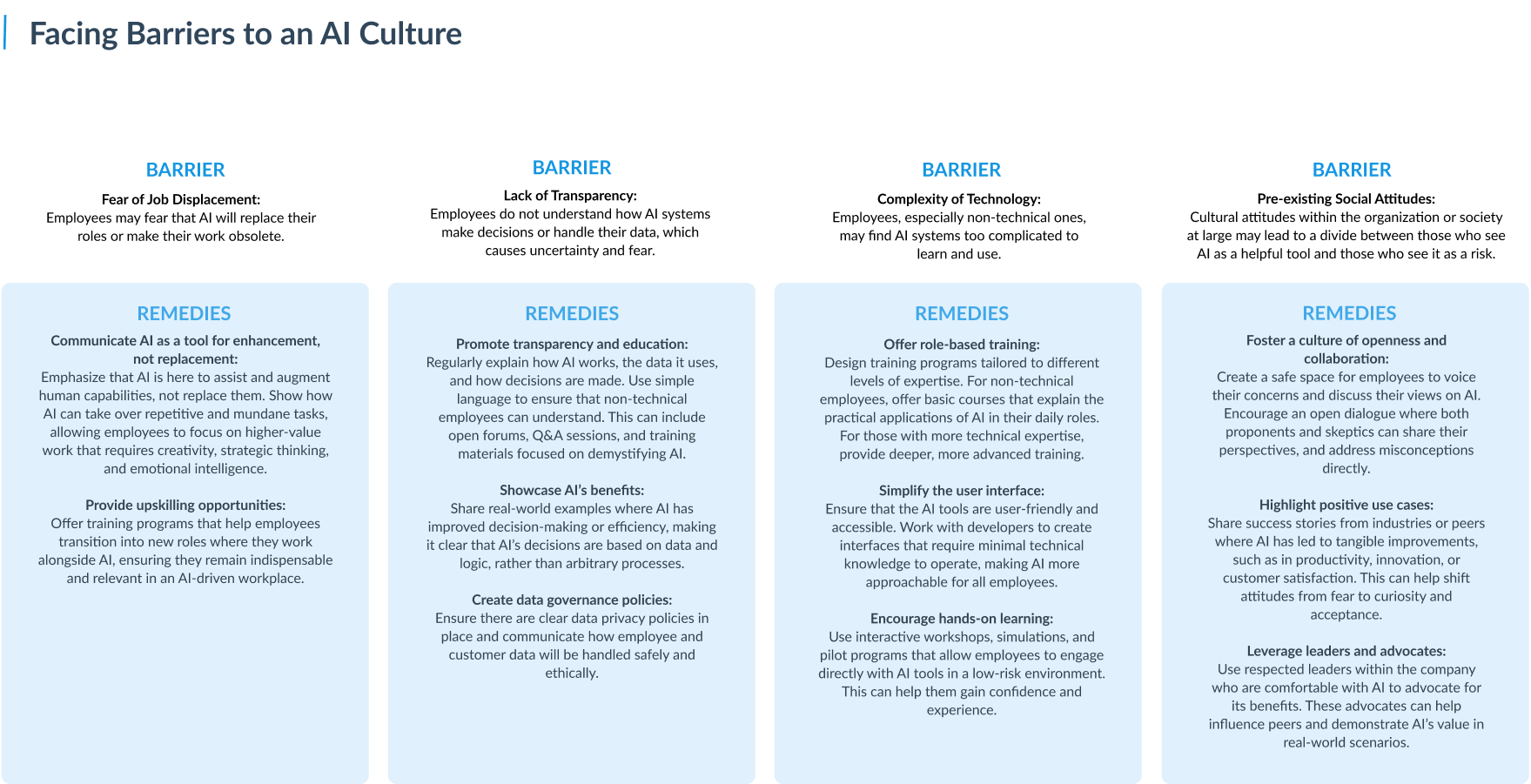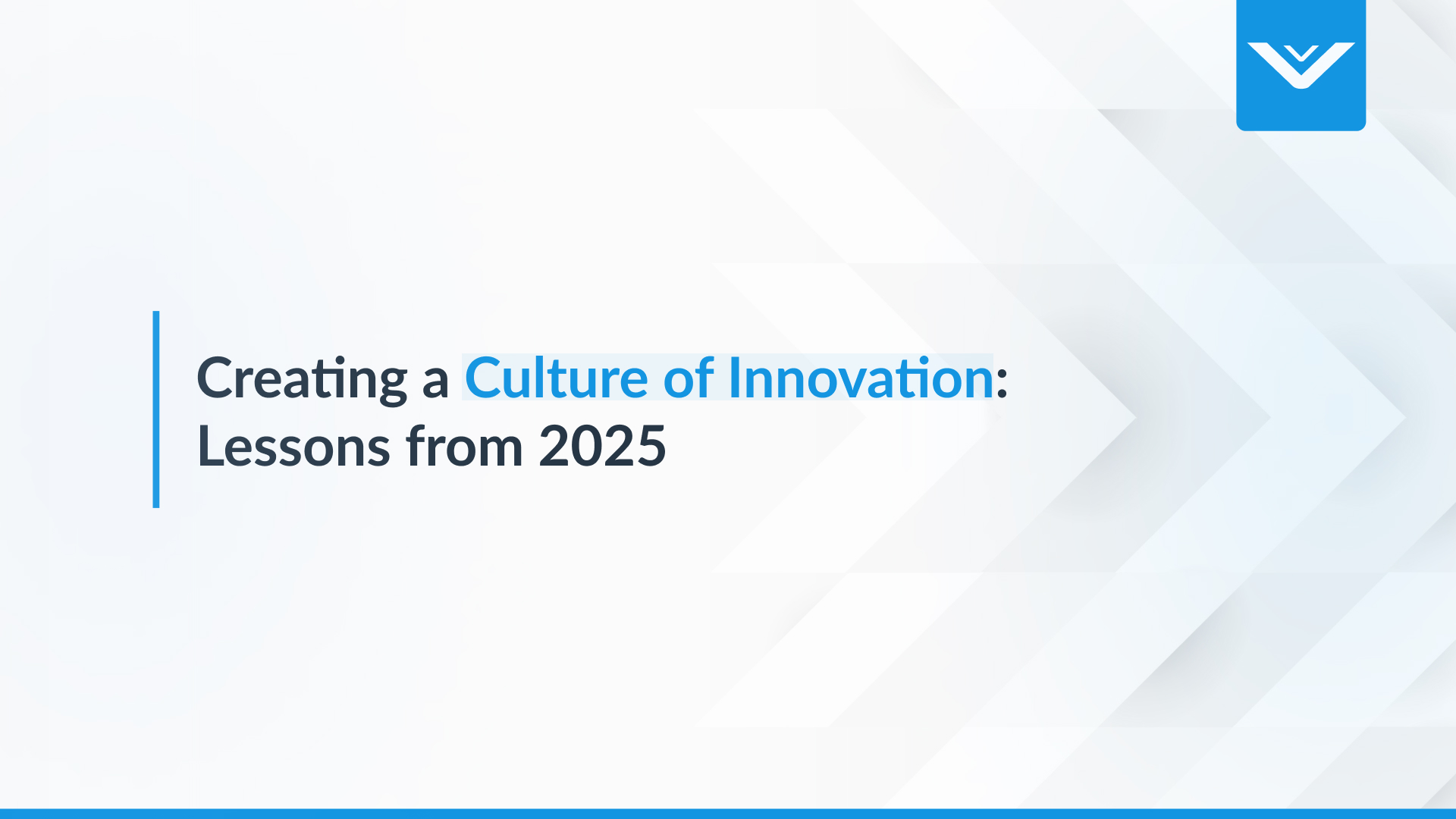

Discover how to cultivate an effective AI culture in your organization. Explore strategies for fostering AI adoption and innovation in our latest blog post.
AI-Driven Innovation: How to Foster a Culture of AI Adoption in Your Organization
Artificial intelligence, or AI, is now a key part of digital transformation. It is changing how people at companies do their work and how they compete with others. But to really get the most out of artificial intelligence, an organization needs more than just the technology. The company must have a strong organizational culture that helps with the use and growth of AI.
To welcome artificial intelligence, it is important for people in a company to focus on innovation, keep learning, and be flexible. This way, everyone—from top to bottom—helps push change forward. In this fast-moving world of business, building a company culture that supports artificial intelligence and digital transformation can open up new chances and keep the business growing. Our team of AI experts provides insights into how you can start creating this strong base by involving leaders first.
Key Highlights
- Leadership buy-in is essential for driving AI adoption and shaping a forward-thinking organizational culture.
- Employee upskilling and ongoing AI training across all departments bridge the AI skills gap and foster workforce readiness.
- Addressing cultural resistance and employee concerns about artificial intelligence ensures smoother digital transformation.
- Innovation thrives when organizations encourage experimentation, cross-functional collaboration, and ethical AI guidelines.
- Implementing clear change management frameworks supports seamless AI integration and long-term competitive advantage.
- Building a sustainable, AI-driven culture requires a unified approach to leadership, training, and transparent communication.
The Role of Leadership in Driving AI Adoption
Strong and clear leadership is the main reason that allows businesses to use artificial intelligence tools and bring real digital transformation. Leaders, like the chief technology officer and the executive team, have the job to make sure that AI adoption lines up with the main business goals. They also help lead the cultural transformation needed. When leaders share a clear view for AI and show that they are serious about it, the whole workforce is more willing to use new technology.
A supportive organizational culture starts when leaders take real steps to answer questions about ai and help their teams get ready for changes. Having leaders who fully back these changes is not just good for the company—it is the most important thing for beating challenges and keeping success going. The next sections talk about how leadership can guide organizational culture as they turn to artificial intelligence and push for lasting changes with digital transformation.
Defining Leadership’s Influence on Organizational AI Transformation
Leadership has a deep effect on how the organizational culture grows and how well artificial intelligence is put in place. Leaders are the ones who shape the vision, set what people should aim for, and explain things when changes happen. They have a big role in how AI is accepted and made part of the workforce. When leaders give a clear direction, the employees are more likely to work toward the goals of the organization.
A good leader goes beyond saying yes to artificial intelligence. They help everyone in the group move the same way and respond fast to changes. They make sure the culture changes with the new technology. This is done not just by making big choices, but by also showing day-to-day behaviors that focus on new ideas and learning as you go. Organizational culture shapes every part of using AI, from trying out ideas to making them a regular part of work. This can decide if the digital transformation will work well or not.
Leaders build trust and help things be clear by sharing openly and leading by example. When leaders are seen and involved, employees feel free to accept AI, work better with new ways, and keep building the cultural transformation.
Strategies for Securing Leadership Buy-In and AI Advocacy
Gaining support from leadership is essential to make AI adoption real. The most successful organizations use different ways to get leaders in, move forward with artificial intelligence, and build support in the business.
- Align AI with business goals: Make sure every artificial intelligence project helps the company’s main mission and business goals.
- Create a clear ROI narrative: Share real data and examples to show how AI can bring results like better use of time or more money for the company.
- Foster transparency: Keep leaders in the loop with frequent updates, positive stories, and open talks about any problems or new chances.
- Champion advocacy: Find key people in the company who can show others how to use AI and share smart tips with everyone.
To effectively drive AI adoption, leadership must first ensure that AI initiatives are strategically aligned with the company’s overarching business objectives. Defining the purpose of AI adoption clearly is essential for securing stakeholder buy-in and guiding the selection of the right AI technologies. By emphasizing operational efficiency, AI can significantly enhance processes such as automating repetitive tasks, improving decision-making, and delivering personalized solutions to customers. However, AI integration must also be guided by ethical principles to ensure transparency, accountability, and fairness. Leaders should prioritize maintaining these ethical standards to foster trust among employees and customers, thereby mitigating potential risks related to bias or misuse of AI technologies
Having a clear story and facts that show the value of artificial intelligence makes leaders want to back new technology. When leaders back AI, it helps build a culture of innovation, so your company is ready to move forward with digital transformation. Think about how your leadership teams work. How can you begin to build stronger AI support today?
.jpg)
Empowering Employees Through Comprehensive AI Training
AI training and upskilling are very important for helping the workforce do well in this digital-first world. Right now, many organizations do not have enough AI skills, and this can make it hard for them to try new things and move forward with AI. When a company spends time and money on good training programs, it helps everyone on the team, not just data scientists, get ready to use AI tools the right way.
People working in HR, marketing, operations, and other areas can all benefit from knowing more about AI. Upskilling is not just done once and forgotten; it is something that has to keep happening. This helps staff get better at what they do and feel confident when working with AI. It also gives a chance for real cultural transformation inside the company. Up next, we will look at how organizations can close this ai skills gap and help their workforce find training paths that last.
Addressing the AI Skills Gap Across All Departments
Many companies find it hard to keep up with new technology because of an AI skills gap in the workforce. Employees often feel they do not have what they need to use artificial intelligence at work. While data scientists and other technical teams are important, it is also key for people in sales, HR, and marketing to know the basics of AI. For a digital transformation, companies have to put effort and time into upskilling everyone.
Building AI knowledge should not just be about technical training for a few people. AI learning should reach every area of the company. For example, HR should learn how AI can help find and hire the right people. Marketers need to know how to use AI to look at data and improve their campaigns. If every team learns about AI, people can spot chances to use it, clear up ambiguity, and try new ideas with confidence.
Companies must see that AI use is something for all workers, not just a few. When all employees feel sure of themselves while using AI, the company will grow together. Think about how your teams would gain from special training to address the AI skills gap and get more out of artificial intelligence.
Developing Ongoing Training Programs and Certification Pathways
Building a culture ready for AI requires more than one-off training sessions. Structured, ongoing learning opportunities and certification pathways help organizations keep pace with advancements in artificial intelligence. These programs should offer scalable options for both technical and non-technical teams, ensuring sustained workforce upskilling.
To effectively empower employees through comprehensive AI training, organizations must prioritize structured and strategic upskilling initiatives. According to our research, organizations are increasingly addressing skill gaps through internal development and upskilling programs. These programs are essential for ensuring employees can adapt to emerging technologies and organizational needs.

Challenges such as lack of awareness or limited resources can be overcome by leveraging online platforms, peer mentoring, and industry partnerships. Ongoing training is not just about compliance—it’s about building a confident, adaptable workforce. Encourage your teams to pursue continuous education and certifications, making AI literacy a long-term organizational asset.
Overcoming Cultural Resistance to AI Integration
Resistance to AI adoption is normal. People at work often hesitate when they see new technology or worry about what it might do. The organizational culture at a company can make this feeling stronger or help people get through the ambiguity and change. Many workers have some fears. They are often afraid they might lose their job or not know how to use new systems. Some may also think that the new technology is complicated.
Our community of technology executives identified a lack of time and resources as the most significant barriers to driving innovation within their teams. While AI initiatives may require time and resources to be implemented effectively, it is better to make room for them now than to be left behind in the AI revolution.
To help everyone get past these barriers, leaders need to listen and show understanding. Leaders should say clearly why there is a digital transformation. They should explain what AI can do for people at work. It helps to talk honestly with the whole team. Leaders must show their support and make sure people see the good things about using AI. There will be better results if everyone knows why people might resist at first. This way, teams can have a culture ready for new ideas and experimentation, even when there is ambiguity.
Understanding Common Barriers and Employee Concerns
Employees do not always want to use artificial intelligence (AI) right away. They may have a few worries. Many of these worries come from organizational culture and how people around them see things. Some of the main barriers are:
- Fear of job displacement: Some people think AI will take their job away or make their work go away.
- Lack of transparency: Employees do not know how AI makes choices or what happens to their data. This can make them worry about AI systems.
- Complexity of technology: If you do not work in tech, learning new AI systems can feel too hard.
- Pre-existing social attitudes: Culture in your country or at your job can change how people think. Some will see AI as a helpful tool. Others see it as a risk and do not want it.

1. Fear of Job Displacement
Barrier: Employees may fear that AI will replace their roles or make their work obsolete.
Remedy:
- Communicate AI as a tool for enhancement, not replacement: Emphasize that AI is here to assist and augment human capabilities, not replace them. Show how AI can take over repetitive and mundane tasks, allowing employees to focus on higher-value work that requires creativity, strategic thinking, and emotional intelligence.
- Provide upskilling opportunities: Offer training programs that help employees transition into new roles where they work alongside AI, ensuring they remain indispensable and relevant in an AI-driven workplace.
2. Lack of Transparency
Barrier: Employees do not understand how AI systems make decisions or handle their data, which causes uncertainty and fear.
Remedy:
- Promote transparency and education: Regularly explain how AI works, the data it uses, and how decisions are made. Use simple language to ensure that non-technical employees can understand. This can include open forums, Q&A sessions, and training materials focused on demystifying AI.
- Showcase AI’s benefits: Share real-world examples where AI has improved decision-making or efficiency, making it clear that AI’s decisions are based on data and logic, rather than arbitrary processes.
- Create data governance policies: Ensure there are clear data privacy policies in place and communicate how employee and customer data will be handled safely and ethically.
3. Complexity of Technology
Barrier: Employees, especially non-technical ones, may find AI systems too complicated to learn and use.
Remedy:
- Offer role-based training: Design training programs tailored to different levels of expertise. For non-technical employees, offer basic courses that explain the practical applications of AI in their daily roles. For those with more technical expertise, provide deeper, more advanced training.
- Simplify the user interface: Ensure that the AI tools are user-friendly and accessible. Work with developers to create interfaces that require minimal technical knowledge to operate, making AI more approachable for all employees.
- Encourage hands-on learning: Use interactive workshops, simulations, and pilot programs that allow employees to engage directly with AI tools in a low-risk environment. This can help them gain confidence and experience.
4. Pre-existing Social Attitudes
Barrier: Cultural attitudes within the organization or society at large may lead to a divide between those who see AI as a helpful tool and those who see it as a risk.
Remedy:
- Foster a culture of openness and collaboration: Create a safe space for employees to voice their concerns and discuss their views on AI. Encourage an open dialogue where both proponents and skeptics can share their perspectives, and address misconceptions directly.
- Highlight positive use cases: Share success stories from industries or peers where AI has led to tangible improvements, such as in productivity, innovation, or customer satisfaction. This can help shift attitudes from fear to curiosity and acceptance.
- Leverage leaders and advocates: Use respected leaders within the company who are comfortable with AI to advocate for its benefits. These advocates can help influence peers and demonstrate AI’s value in real-world scenarios.
By addressing these barriers head-on with clear communication, education, and practical support, organizations can successfully overcome resistance to AI and build a culture of acceptance and innovation.
Different cultures have different views and hopes about change. In some places, people like things to stay the same. This makes new tech, like artificial intelligence, feel like a big risk. In other places, people are open to trying new things and like to do more experimentation. Stories on social media about bad experiences with AI can make it harder for people to trust new tools.
If your organization gives people clear information and listens, the team might feel better about trying new technology. This helps lower fear and makes it easier to use AI at work. Think about this: is your organization doing enough now to deal with these issues?
Methods for Fostering Openness and “Safe to Fail” Mindsets
Promoting a culture of innovation means that people are asked to try new things with AI even if not every idea works the first time. When it is safe to fail at work, people become more agile and confident. The team can test and use new technology without worrying about something bad happening if things go wrong.
Leaders can help by doing a few things:
- Share stories about both good and bad projects so that everyone feels OK to learn from what goes wrong.
- Give people the time and the things they need to join in AI pilot projects or events like hackathons.
- Thank and reward not just perfect work but also creative thinking and the courage to try new things.
Having a “safe to fail” setup is key to growing trust in the team and letting everyone keep trying new things with AI. When people feel this way, they feel free to speak up with new ideas, ask the team about their problems, and take careful risks. Help your team see a failure with new technology or in AI work as just another way to learn, not a huge problem. This way of thinking is important so every AI change can go well, and your culture of innovation will get even better with time thanks to all the experimentation and agility.
Building an Innovation-Focused Environment for AI Success
Nurturing a culture of innovation is key if you want to succeed with AI adoption. This is also how you keep a strong competitive advantage in the field of AI. The organizations that do well in this area give their people chances to try new things. They reward curiosity. They make sure that innovation is built into each day’s work and not just something you see every so often.
Innovation is not only about new technology. It is also about bringing people together from different parts of the company. It’s about working with ethical responsibility, too. To build a strong culture of innovation, people have to connect what is possible with AI and the values that matter to their workplace. The next parts will show some simple ways to help your team work together, and to set clear ethical rules, so that AI helps your business grow in the right way.
.jpg)
Encouraging Cross-Functional Collaboration and Experimentation
Driving AI adoption works best when people from different teams come together. If data scientists, HR, and operations all work as one team, they share their own skills. This helps them solve hard problems and find strong answers. When there is more experimentation between teams, people become more creative. Teams can also discover more ways to use generative AI.
Organizations can support collaboration by:
- Setting up cross-departmental teams or groups that focus on A projects.
- Running workshops for new ideas, hackathons, or “AI sprints” so staff can build and try out new things.
- Giving people ways to share what they have learned, seen, and done with AI.
These kinds of collaborative settings help to make an organization’s ability to adapt and come up with new ideas much better. If everyone is involved and cares about the outcome, ai projects are more likely to work. Think about how your organization can help people work together and try out new things, instead of staying apart.
One way to encourage cross-functional collaboration is to evaluate AI use cases by level of effort and level of collaboration needed. For example, when you use generative AI and deep learning, you can make content creation work better for all teams in the office. This means your team can work faster and be more efficient. By telling shared use cases apart from team ones, you can use your resources well and reach business goals. It also helps you line up the right AI tools for what your company needs most, so you get the most out of them.
Creating Guidelines and Balancing Responsibility with Innovation
As more groups use artificial intelligence in their work, it is important to find the right mix between new ideas and doing what is right. Having clear rules helps be sure that AI is used in a way that is open, fair, and that someone takes the blame if things go wrong.
Key points to remember:
- Transparency: Make sure people can understand how artificial intelligence makes its choices.
- Bias prevention: Keep watching your computer programs so that they do not treat anyone unfairly.
- Accountability: Make it clear who should answer for what AI does.
- Ongoing oversight: Keep checking and updating your AI rules to match what others in the business do, like Microsoft’s rules for using ai in the right way.
Using responsible AI in your group helps keep workers and the business safe. It also builds trust with your own people and with others outside the business. Try to have your leaders stand up for using AI the right way—this will help your group be a leader as more people move into digital transformation.
Conclusion
In the end, the best way to help your business grow and bring in new ideas is to build a culture of AI adoption. Start by making sure the leaders are on board and put time and money into good training programs. This gives you a strong starting point to bring ai into your team’s daily work. It’s important to deal with any pushback from your team and help make a place where everyone feels safe to try new things and see what works with AI and experimentation.
Remember, the move toward an AI-driven future is a team effort. It needs everyone to work together and stay committed. When you take each step, be sure to talk with your team and keep them involved. Doing this will help your company stay ahead in the digital world. If you want to use AI to take your business to the next level, reach out to our team. Our experts are here to help you on the way.
Spread the word.
Thousands of subscribers receive our newsletter every week breaking down what's happening across the technology community.
Join them today.
Keep Reading
.jpg)
Topic-Focused Innovation Advisory Councils: Year-End Insights
We finished up our 2025 Innovation Advisory Council calendar with three insightful, topic-focused sessions that revealed both the urgency and the opportunity ahead as companies seek to modernize responsibly and create lasting value.


Creating a Culture of Innovation: Lessons from 2025
Creating a culture of innovation means staying curious, supporting teams through uncertainty, and continuously raising the bar for what’s possible. The technology will keep changing. The pace will keep accelerating. But organizations that invest in their people and cultivate the right culture will always find their next summit and the energy to climb it.


.jpg)
